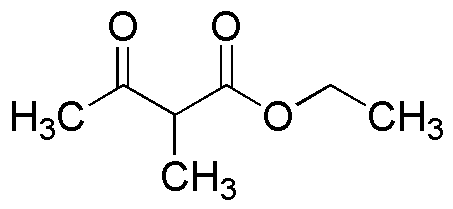Ethyl 2-methylacetoacetate is widely utilized in research focused on:
- Synthesis of Pharmaceuticals: This compound serves as a key intermediate in the synthesis of various pharmaceuticals, particularly in creating anti-inflammatory and analgesic drugs, enhancing their efficacy.
- Flavor and Fragrance Industry: It is used in the formulation of flavors and fragrances, providing a fruity scent that is popular in food products and personal care items.
- Organic Synthesis: Researchers leverage its reactivity in organic synthesis, enabling the construction of complex molecules, which is crucial in developing new materials and chemicals.
- Polymer Production: Ethyl 2-methylacetoacetate is utilized in producing specialty polymers, contributing to materials with enhanced properties like flexibility and durability.
- Research in Agrochemicals: This compound is explored in the development of agrochemicals, including pesticides and herbicides, aiming to improve agricultural productivity while minimizing environmental impact.
General Information
Properties
Safety and Regulations
Applications
Ethyl 2-methylacetoacetate is widely utilized in research focused on:
- Synthesis of Pharmaceuticals: This compound serves as a key intermediate in the synthesis of various pharmaceuticals, particularly in creating anti-inflammatory and analgesic drugs, enhancing their efficacy.
- Flavor and Fragrance Industry: It is used in the formulation of flavors and fragrances, providing a fruity scent that is popular in food products and personal care items.
- Organic Synthesis: Researchers leverage its reactivity in organic synthesis, enabling the construction of complex molecules, which is crucial in developing new materials and chemicals.
- Polymer Production: Ethyl 2-methylacetoacetate is utilized in producing specialty polymers, contributing to materials with enhanced properties like flexibility and durability.
- Research in Agrochemicals: This compound is explored in the development of agrochemicals, including pesticides and herbicides, aiming to improve agricultural productivity while minimizing environmental impact.
Documents
Safety Data Sheets (SDS)
The SDS provides comprehensive safety information on handling, storage, and disposal of the product.
Product Specification (PS)
The PS provides a comprehensive breakdown of the product’s properties, including chemical composition, physical state, purity, and storage requirements. It also details acceptable quality ranges and the product's intended applications.
Certificates of Analysis (COA)
Search for Certificates of Analysis (COA) by entering the products Lot Number. Lot and Batch Numbers can be found on a product’s label following the words ‘Lot’ or ‘Batch’.
*Catalog Number
*Lot Number
Certificates Of Origin (COO)
This COO confirms the country where the product was manufactured, and also details the materials and components used in it and whether it is derived from natural, synthetic, or other specific sources. This certificate may be required for customs, trade, and regulatory compliance.
*Catalog Number
*Lot Number
Safety Data Sheets (SDS)
The SDS provides comprehensive safety information on handling, storage, and disposal of the product.
DownloadProduct Specification (PS)
The PS provides a comprehensive breakdown of the product’s properties, including chemical composition, physical state, purity, and storage requirements. It also details acceptable quality ranges and the product's intended applications.
DownloadCertificates of Analysis (COA)
Search for Certificates of Analysis (COA) by entering the products Lot Number. Lot and Batch Numbers can be found on a product’s label following the words ‘Lot’ or ‘Batch’.
*Catalog Number
*Lot Number
Certificates Of Origin (COO)
This COO confirms the country where the product was manufactured, and also details the materials and components used in it and whether it is derived from natural, synthetic, or other specific sources. This certificate may be required for customs, trade, and regulatory compliance.


